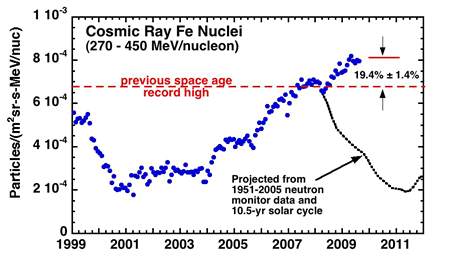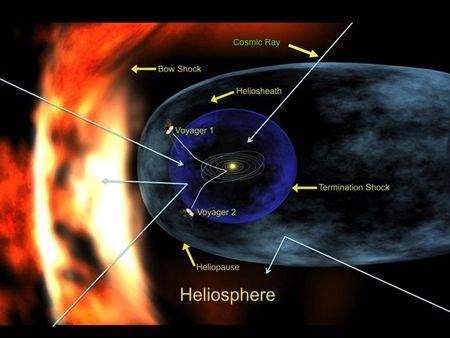Watch out, space travelers: galactic cosmic rays have hit their highestt levels since the space age began.
“In 2009, cosmic ray intensities have increased 19 percent beyond anything we’ve seen in the past 50 years,” says Richard Mewaldt of Caltech. “The increase is significant, and it could mean we need to rethink how much radiation shielding astronauts take with them on deep-space missions.”

The reason is the solar minimum, a deep lull in solar activity: cosmic rays increase as solar activity declines. Right now solar activity is as weak as it has ever been in modern times.
Galactic cosmic rays are subatomic particles – mainly protons but also some heavy nuclei – accelerated to near light speed by distant supernova explosions. They cause ‘air showers’ of secondary particles when they hit Earth’s atmosphere. They’re a health hazard to astronauts, and a single cosmic ray can disable a satellite if it hits an unlucky integrated circuit.
The sun’s magnetic field – the heliosphere – is our first line of defense, scattering and deflecting the rays. The solar wind enhances this effect.

“At times of low solar activity, this natural shielding is weakened, and more cosmic rays are able to reach the inner solar system,” explains Dean Pesnell of the Goddard Space Flight Center.
Right now, the sun’s magnetic field is weak, and solar wind pressure is at a 50-year low. If trends continue, says Dean Pesnell of the Goddard Space Flight Center, “We could see cosmic ray fluxes jump all the way to 30 percent above previous Space Age highs,” predicts Mewaldt.
Earth is in no great peril from the extra cosmic rays. The planet’s atmosphere and magnetic field combine to form a formidable shield against space radiation, protecting humans on the surface. Indeed, we’ve weathered storms much worse than this. Hundreds of years ago, polar ice cores show, cosmic ray fluxes were at least 200 percent higher than they are now.
“The space era has so far experienced a time of relatively low cosmic ray activity,” says Mewaldt. “We may now be returning to levels typical of past centuries.”






